Test your knowledge of macaque behaviour, facial expressions and vocalisations using our short, interactive quiz.

There could be more than one correct answer for this question.
Correct
Social grooming is an indicator of positive welfare, but it does depend on the context. It is mainly performed in relaxed social situations, but brief bouts of grooming may occur following a stressor.
Incorrect
Social grooming is an indicator of positive welfare, but it does depend on the context. It is mainly performed in relaxed social situations, but brief bouts of grooming may occur following a stressor.
There could be more than one correct answer for this question.
Correct text
The bark is a single, loud, harsh sound given in threatening situations, including agonistic social interactions. Rhesus macaques have a high-pitched “shrill bark” which is considered to be an alarm call.
Incorrect
The bark is a single, loud, harsh sound given in threatening situations, including agonistic social interactions. Rhesus macaques have a high-pitched “shrill bark” which is considered to be an alarm call.

There could be more than one correct answer for this question.
Correct.
This facial expression is a grimace or bared-teeth display. It signals submission and is intended to avert possible aggression from other individuals.
Incorrect.
This facial expression is a grimace or bared-teeth display. It signals submission and is intended to avert possible aggression from other individuals.
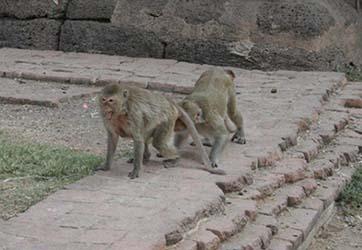
There could be more than one correct answer for this question.
Correct.
Presenting the rump/genitals to another individual indicates submission, performed by the subordinate towards the dominant animal. Females may also present their rump/genitals to males to solicit copulation.
Incorrect.
Presenting the rump/genitals to another individual indicates submission, performed by the subordinate towards the dominant animal. Females may also present their rump/genitals to males to solicit copulation.
There could be more than one correct answer for this question.
Correct.
This is the coo call, which is also performed by other macaque species. It is used in calm, peaceful contexts and helps to maintain auditory contact with group members.
Incorrect. This is the coo call, which is also performed by other macaque species. It is used in calm, peaceful contexts and helps to maintain auditory contact with group members.
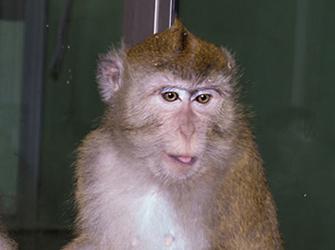
There could be more than one correct answer for this question.
Correct.
This is an affiliative facial expression, with eyes open and looking at another animal, brow relaxed, ears drawn back against the sides of the head, and tongue protruding.
Incorrect.
This is an affiliative facial expression, with eyes open and looking at another animal, brow relaxed, ears drawn back against the sides of the head, and tongue protruding.
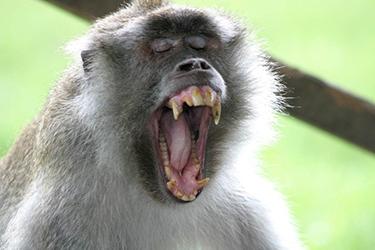
There could be more than one correct answer for this question.
Correct.
Exaggerated yawning with full display of teeth is a threat behaviour, or indicative of tension.
Incorrect.
Exaggerated yawning with full display of teeth is a threat behaviour, or indicative of tension.
There could be more than one correct answer for this question.
Correct.
This scream or squeal is given in response to alarming, painful or fear causing stimuli, and warrants investigation. An animal could be being bullied or attacked by another group member.
Incorrect.
This scream or squeal is given in response to alarming, painful or fear causing stimuli, and warrants investigation. An animal could be being bullied or attacked by another group member.

There could be more than one correct answer for this question.
Correct.
Behavioural indicators of positive welfare include social grooming, resting in close body contact, calm foraging and feeding behaviour, relaxed locomotion and exploration, and play.
Incorrect.
Behavioural indicators of positive welfare include social grooming, resting in close body contact, calm foraging and feeding behaviour, relaxed locomotion and exploration, and play.

There could be more than one correct answer for this question.
Correct.
The open mouth stare is used to threaten other individuals. It is seen during tension between group members, and is often performed towards unwelcome humans.
Incorrect.
The open mouth stare is used to threaten other individuals. It is seen during tension between group members, and is often performed towards unwelcome humans.
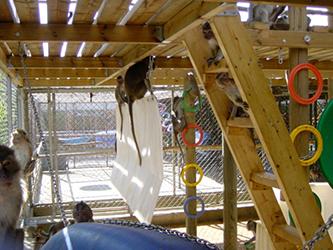
There could be more than one correct answer for this question.
Correct.
Visual barriers can be important for all of these reasons.
Incorrect.
Visual barriers can be important for all of these reasons.
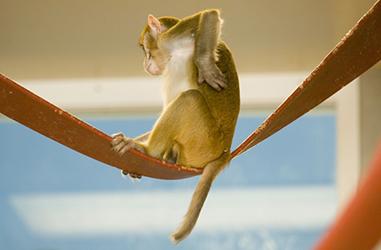
There could be more than one correct answer for this question.
Correct.
Self-scratching is generally an indicator of anxiety in non-human primates, especially if performed at excessive levels.
Incorrect.
Self-scratching is generally an indicator of anxiety in non-human primates, especially if performed at excessive levels.
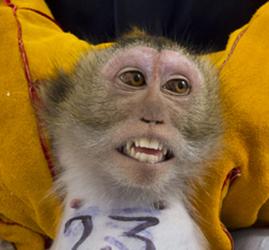
There could be more than one correct answer for this question.
Correct.
This is a fear grin/grimace – an indicator of negative welfare. If a macaque shows grimacing, resistance, flight/escape reactions, vocalisation (scream), urination or defecation in response to a procedure, these are signs of fear and anxiety. Attention should be given to desensitising and habituating the animal to the procedure, to minimise the fear response.
Incorrect.
This is a fear grin/grimace – an indicator of negative welfare. If a macaque shows grimacing, resistance, flight/escape reactions, vocalisation (scream), urination or defecation in response to a procedure, these are signs of fear and anxiety. Attention should be given to desensitising and habituating the animal to the procedure, to minimise the fear response.

There could be more than one correct answer for this question.
Correct.
The activity budgets of wild macaques vary with species and season, but they typically spend around 20-40% of their day foraging for food. Captive macaques should be provided with opportunities for extended bouts of foraging behaviour.
Incorrect.
The activity budgets of wild macaques vary with species and season, but they typically spend around 20-40% of their day foraging for food. Captive macaques should be provided with opportunities for extended bouts of foraging behaviour.

There could be more than one correct answer for this question.
Correct.
All of these behaviours can be considered abnormal because they are not seen under natural conditions. They may affect the animal’s welfare, particularly if performed frequently (e.g. by causing injury or restricting the animal’s behavioural repertoire). They may indicate failure to cope with chronic stress, such as that caused by a poor environment.
Incorrect.
All of these behaviours can be considered abnormal because they are not seen under natural conditions. They may affect the animal’s welfare, particularly if performed frequently (e.g. by causing injury or restricting the animal’s behavioural repertoire). They may indicate failure to cope with chronic stress, such as that caused by a poor environment.
Your score: / 15
Your Ranking: You have more to learn about macaque behaviour. Refresh your knowledge using this website. You have more to learn about macaque behaviour. Refresh your knowledge using this website. You have a good understanding of macaque behaviour. You have more to learn about macaque behaviour. Refresh your knowledge using this website. You have more to learn about macaque behaviour. Refresh your knowledge using this website.


